Philips 48OLED807 Review
An excellent OLED, packed full of features for TV, film fans and avid gamers


Verdict
Philips’s latest 48OLED807 is an excellent OLED, packed full of features for TV, film fans and avid gamers, delivering impressive picture quality and good sound for its size.
Pros
- Sharp, detailed and colourful image
- Better-than-expected sound
- Competitive gaming features
- Stylish design
- Ambilight, of course
Cons
- Not as bright as expected
- LG OLED better overall for gaming
- Remote can be frustrating
Availability
- UKRRP: £1499
- USAunavailable
- EuropeTBC
- Canadaunavailable
- Australiaunavailable
Key Features
- Dark Detail OptimisationReveals more detail in the darkest parts of the image
- Ambilight AuroraAmbilight support for photo galleries and video
- VRRGaming skills enhanced with HDMI VRR, AMD FreeSync and Nvidia G-Sync
Introduction
While Philips may not have the clout of other brands in the TV market – it mainly has a European presence – its OLED TVs have been rated as some of the best for the past several years.
The 8-series OLED is its midrange model, making it the Philips OLED to get if you’re a film and gaming fan and have no need for the integrated sound systems that come with the more expensive 9-series OLEDs.
We reviewed the 55-inch model and gave it five stars. Now, after reviewing the 48-inch model, it would seem the apple doesn’t fall far from the tree.
Design
- Quick enough to assemble
- Stylish aluminium-finish stand that swivels
- Four-sided Ambilight
If you’ve read our review of the 55-inch model, then this 48-inch has the same appearance but in smaller dimensions.
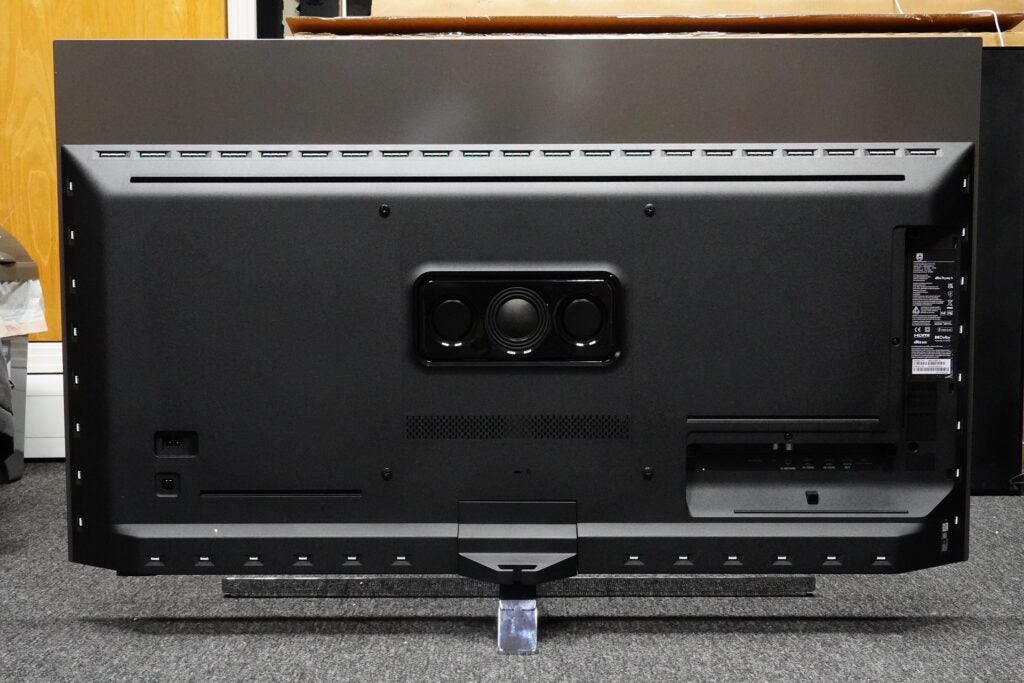
As is customary for Philips, this is a TV built to a high standard, with a smart and thin metal bezel encasing the screen. The gleaming aluminium-polished stand is a stylish addition that can swivel to protect against glares or distracting lights, while viewing angles are consistent with other OLEDs I’ve tested, although some colours (like yellow) can dim quicker than others at wider angles.

Assembling the stand takes less than five minutes. Even though the aluminium finish can attract smudges, they’re not viewable unless you’re very close to it. On the TV’s rear, there’s a small section to pass cables through in order to keep the back area clear of clutter.

Around the back, you’ll also find a few other adornments, such as an integrated rear bass speaker system and, of course, Philips’s patented Ambilight bias system. The latter casts light onto the surface behind that mirrors the colours on-screen, producing an effervescent glow. This version of Ambilight comes in its four-sided form, so there isn’t a gap at the bottom if you intend to wall-mount.

The bulk of the speakers, Ambilight, processors and connections does mean this set juts out with a depth of 68mm. Few, I reckon, will be fussed by that if they’re placing this TV on a wall.
The remote is another stylish effort, although I have an issue with it. I don’t get on with the D-pad, as I find its presses softer than I’d like, and my finger regularly slides off the grooved surfaces, which means I often end up pressing the Home or Back button. If you’ve got big digits like me, the buttons are also placed a little too close.

Interface
- Android TV, not Google TV
- Freeview Play integration
- Philips’s menu is labyrinthine to navigate
For apps and smarts, Philips still bangs the drum for Android TV over Google TV. Android TV comes in for criticism, but I find it easy and simple to use. If anything, updates to make it more like Google TV have confused Android TV’s identity.
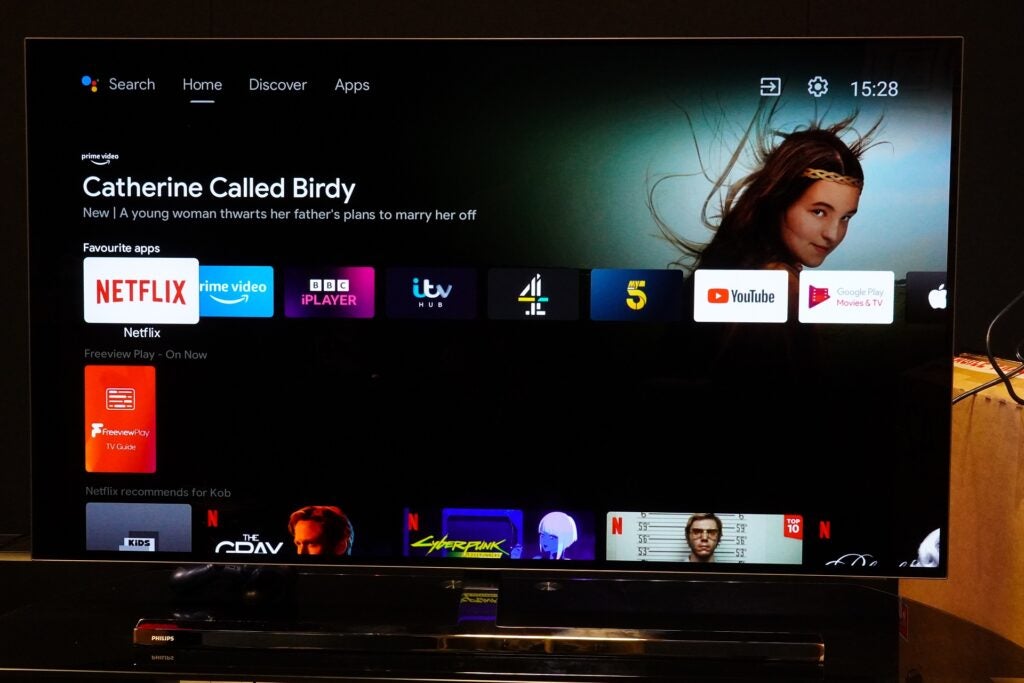
For example, Watchlist should be front and centre on the first page, but it’s still buried within the Discover page, where the recommendations aren’t the most useful, serving up titles I’ve seen or others I’m not keen on.
Discover uses the history of several apps (Disney+, Prime Video, Apple TV+, Rakuten Viki, Discovery+) to push out recommendations, but it lacks the added info Google TV can offer with its Rotten Tomatoes ratings and pricing options. Neither is great at serving up recommendations, but Google TV provides more options.

Apps are plentiful here, and most of the main streaming apps are catered for in their Dolby Vision and Atmos forms. Freeview Play brings the UK catch-up and on-demand apps, and for gaming, you’ll find cloud streaming options of Nvidia GeForce and the soon-to-depart Google Stadia onboard.
There’s another interface to consider: the labyrinthine Philips menu for changing settings for picture, sound, Ambilight, and more. It’s helpful at least in that it provides explanations for each setting.

Features
- Wide VRR gaming support
- DTS Play-Fi adds speakers to the set-up
- New Ambilight Aurora feature
All four of the 48OLED807’s HDMI inputs support an ARC connection to a soundbar. If you want to pass-through lossless home cinema audio, such as Dolby Atmos, then the eARC connection on HDMI 2 provides that.
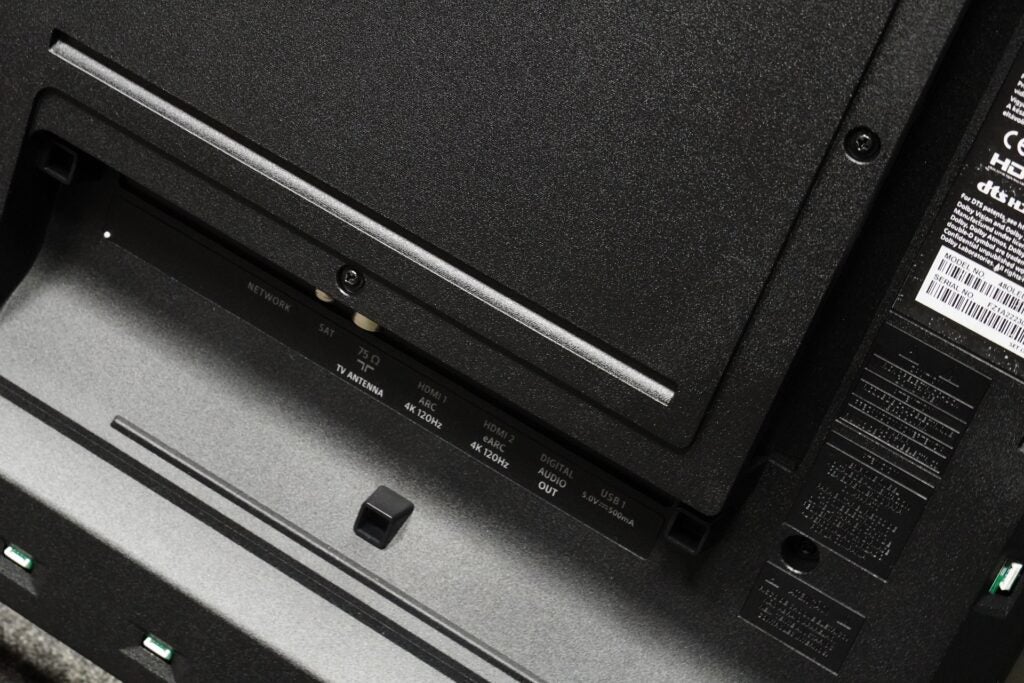
The rest of the connections include the usual fare: three USB ports, Common Interface Plus module, Ethernet, digital optical audio out, headphone out, aerial and satellite connectors. Wireless options are covered by Wi-Fi and Bluetooth 5.0.
Coverage for the HDMI 2.1 standard includes the aforementioned eARC, VRR (Variable Refresh Rate) and ALLM (Auto Low Latency Mode). VRR sees a full house with HDMI VRR, AMD FreeSync Premium Pro and Nvidia G-Sync. These adapt the refresh rate of the screen to that of the console/PC for improved visual fidelity and responsiveness.
ALLM automatically puts the TV into its lowest latency mode, which I measured to be 15.2ms. That’s quick: not as quick as LG and Samsung, but around the same speed as Panasonic and faster than Sony. VRR can reduce the response time to even lower levels.
With two 4K/120Hz connections, there’s a choice of which port to plug a console/PC into, but be aware that one of these ports is shared with the eARC input, so you are limited if you decide to add a soundbar.
The 48OLED807’s gaming skills are further buffed up with the tonic of the Dolby Vision Game mode, currently supported by the Xbox Series consoles, which improves HDR performance, black levels and contrast. HGiG instigates a more consistent HDR performance across a range of displays. Considering where Philips was only a couple of years ago, this level of game support is a big turnaround.
Alongside the apps provided by Android TV, the interface also adds native Google Assistant voice support (via the remote) and Chromecast. If that wasn’t enough, there is “Works with Alexa” compatibility, where Alexa is available through a connected device (such as an Echo speaker).
Is there more? Yes, there is. DTS Play-Fi is a wireless home audio standard that allows for compatible speakers/soundbars from any brand to be connected wirelessly to the 48OLED807. The TV can act as the centre speaker, or form part of a multi-room chain with other speakers in a house.
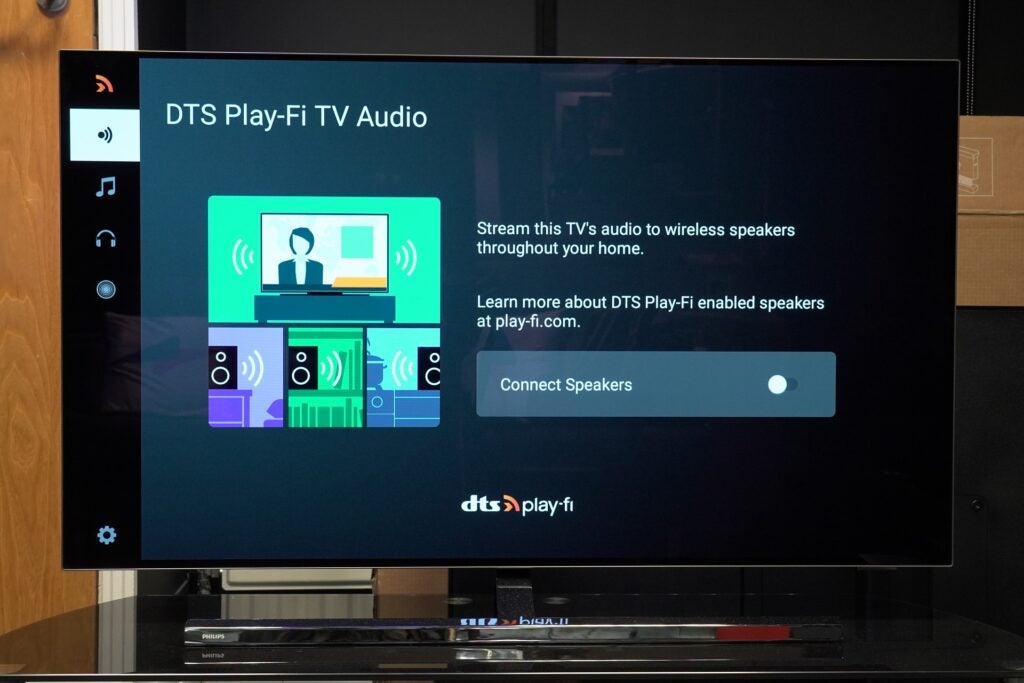
IMAX Enhanced presents IMAX content in its optimal viewing condition, and heading back to Ambilight, it’s the next-gen Ambilight version with more LED pixels to enable precise control and a wider range of colours.
The Ambilight Aurora is a gallery with preloaded images and videos, activated when the screen goes to sleep, so you’re not confronted with a huge black screen.
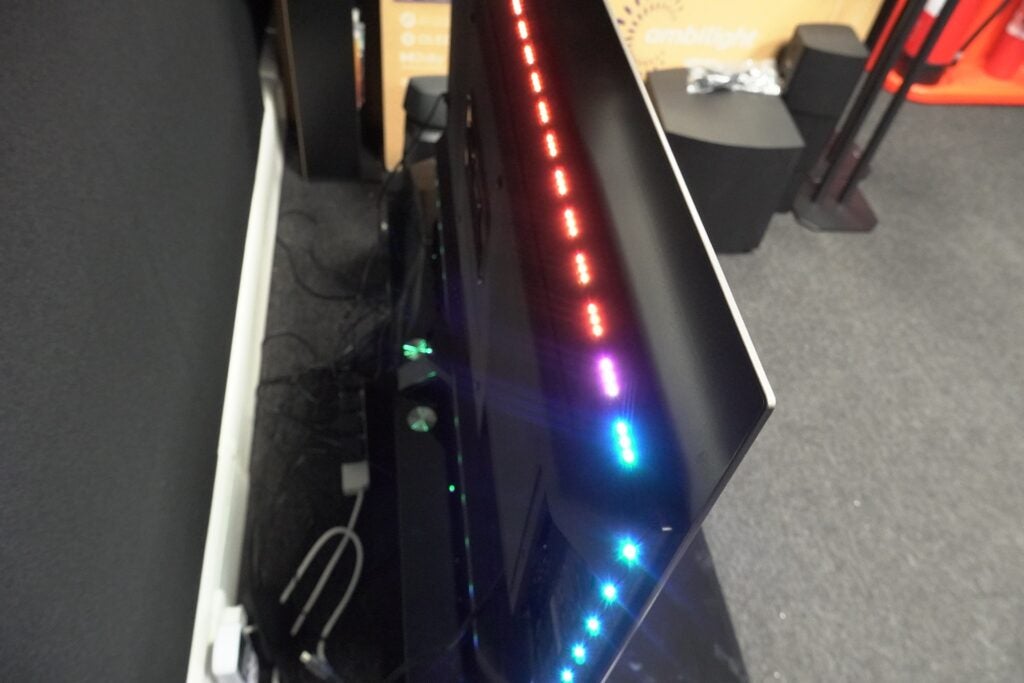
Picture Quality
- All major HDR formats covered
- Impressively sharp and detailed image
- Not as much dark detail
Unlike with Philips’s LCD TVs, there’s less tweaking to be done out of the box with the 48OLED807. The first thing you’ll notice is how sharp and detailed this TV’s pictures are – the P5 AI processor wrings out as much detail, contrast and colour as it can find.

Compared to the Samsung QN90B, the 48OLED807 makes the former TV’s detail levels look soft when playing Doctor Strange in the Multiverse of Madness. With the Philips, I could see the bristles of Strange’s beard with more clarity, and the wrinkles and crow’s feet around people’s eyes were revealed for an all-round sharper image.
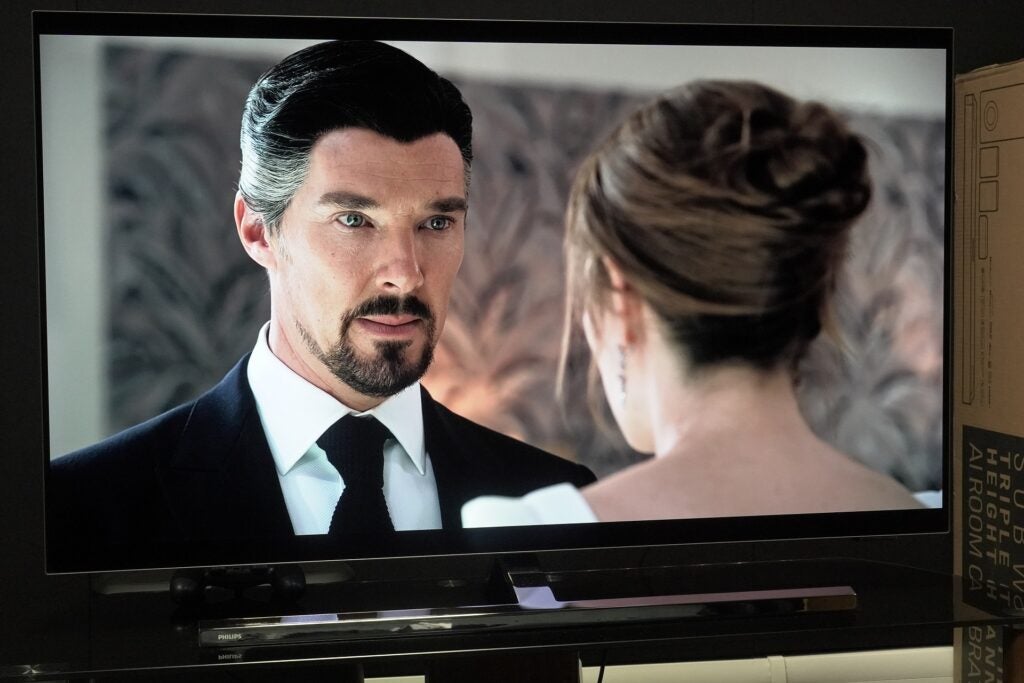
This TV is not as bright as I first anticipated it to be: the Home Cinema and Personal presets offer 340 and 416 nits on a 5% HDR window, while the Filmmaker mode and IMAX Enhanced pushed it to 624 and 632 nits, respectively. The 48-inch Philips does not have the OLED EX panel to boost brightness, which would explain why even the 42-inch LG C2 is brighter on paper.
But you wouldn’t necessarily think the LG is that much brighter when looking at the images on the TV. The 48OLED807’s trick seems to be in how it deals with white tones.
In a scene of She-Hulk: Attorney at Law where Matt Murdock and Jennifer Walters are (verbally) sparring in court, the white tones of the shafts of light beaming through the blinds as well as the light that shines on Murdock’s suit and face look hotter than they do on the LG C2. It makes the overall image look brighter but still natural enough compared to the LG’s less ebullient picture.
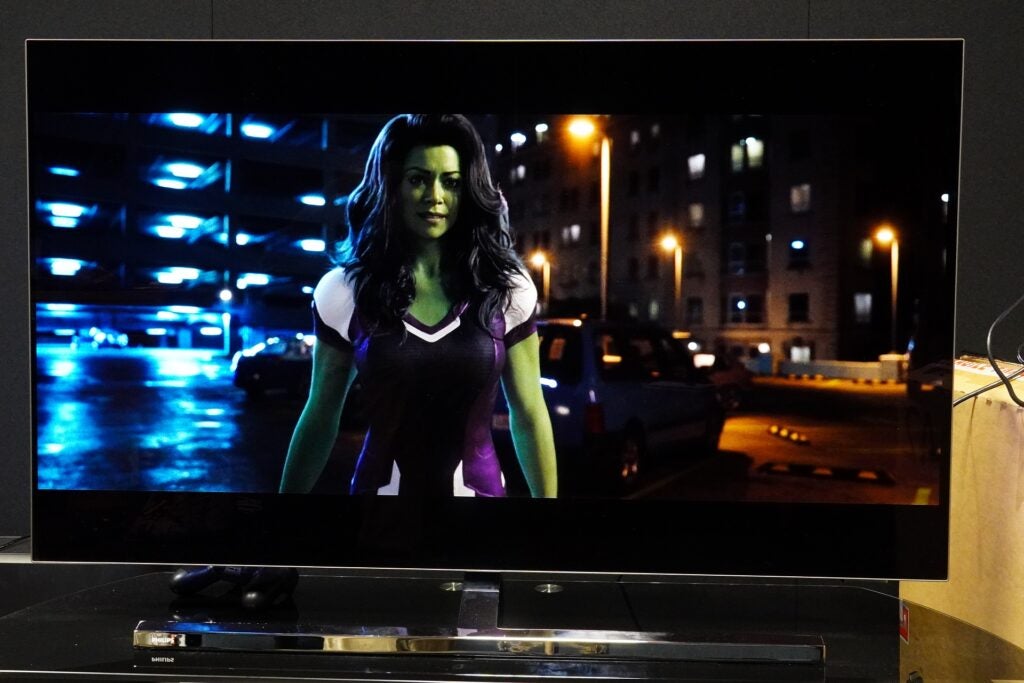
This Philips TV’s contrast is excellent, with black levels firm and deep; the pixel-level dimming prowess of an OLED panel produces pixel-perfect highlights with no visible blooming (haloes around bright objects). Watch the scene where Walters and Daredevil are on top of a goon’s hideout, and the intensity of the neon sign against the darkness of the night makes for a gorgeous image LCD TVs struggle to match.
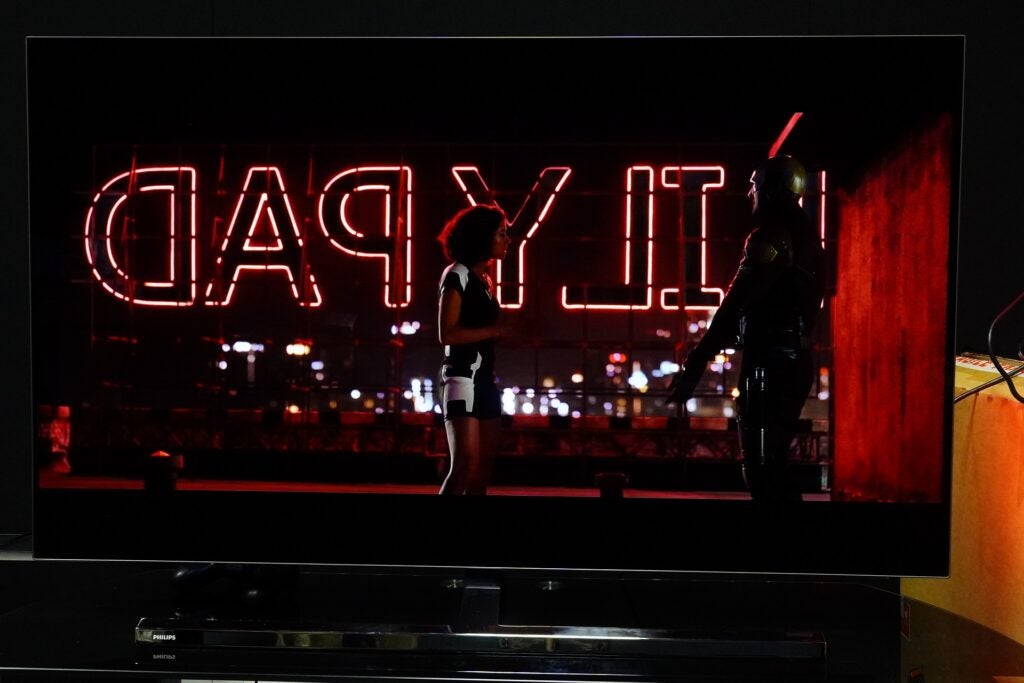
Philips’s way with colour is impressive, although perhaps not altogether accurate: the 48OLED807 is a punchy, vibrant and rich performer. Watching the Man United vs Spurs match on Prime Video (in the Personal mode), the red tones of the home team’s kit are a little too red, and the green of the grass has a little too much zest to it.
You could alter the picture mode, but I wouldn’t – I’m not sure if the colours are what I should be seeing, but I can’t deny that it’s an attractive, eye-catching image. Accuracy be damned.
HDR10, HLG, HDR10+ Adaptive and Dolby Vision HDR formats are covered, with Philips claiming that its processing and Dark Detail Optimisation feature can mimic Dolby Vision IQ, using the TV’s light sensor to adjust the level of dark detail visible depending on how much ambient light there is in a room. This is so you can see every detail you’re meant to see.

I have seen a successful demo of this in action, but in my time with the 48OLED807, I didn’t notice a difference. In a bright room, the Samsung QN90B produced a better performance in terms of low-level dark detail, revealing more of the Sanctum Sanctorum in Doctor Strange, whereas the Philips’s black levels made it more impenetrable.
In terms of motion processing, the 48OLED807 is good, although not without a few caveats. It’s relatively stable and consistent in applying processing, but on stronger settings, I experienced judder watching Tomorrowland on Disney+ that introduced a level of unreality. Nudge it down to the Pure Movie setting and it’s more focused.
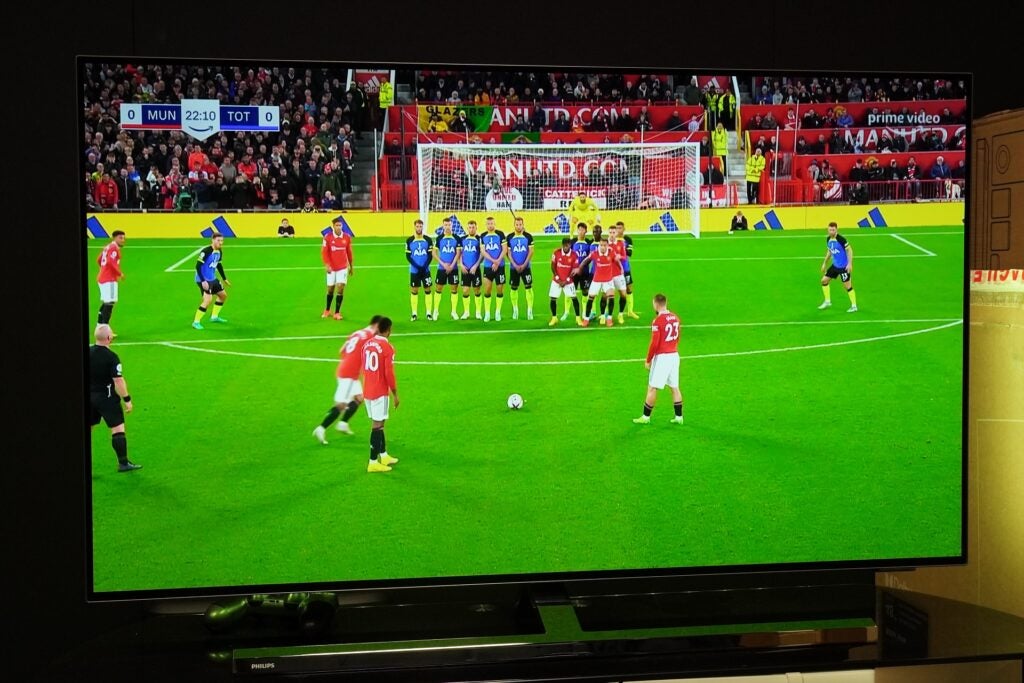
With sports, the Philips is slicker and smoother than Samsung’s QN90B, although keeping up with the ball had the effect of it disappearing or becoming blurry when passed.
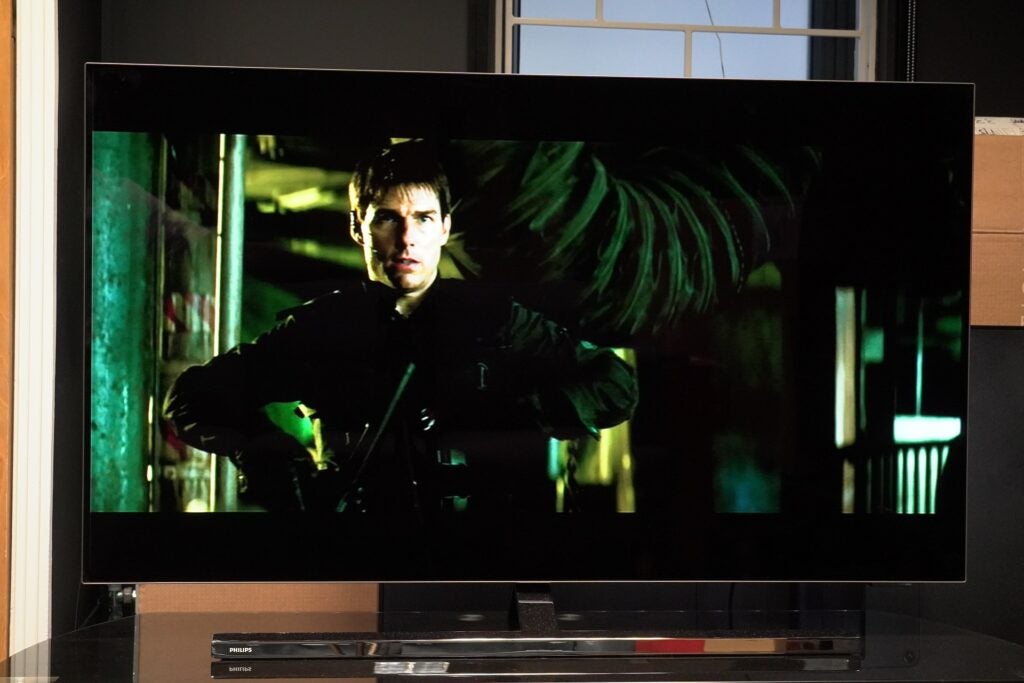
Upscaling is good, but this, naturally, depends on the quality of the source. A DVD of Mission: Impossible III looked fine with its saturated colours but showed obvious signs of softness in some places and noise in others. But the P5 AI processor’s thirst for detail does unearth what it can find and sharpen it, and it just about does this without looking too artificial.
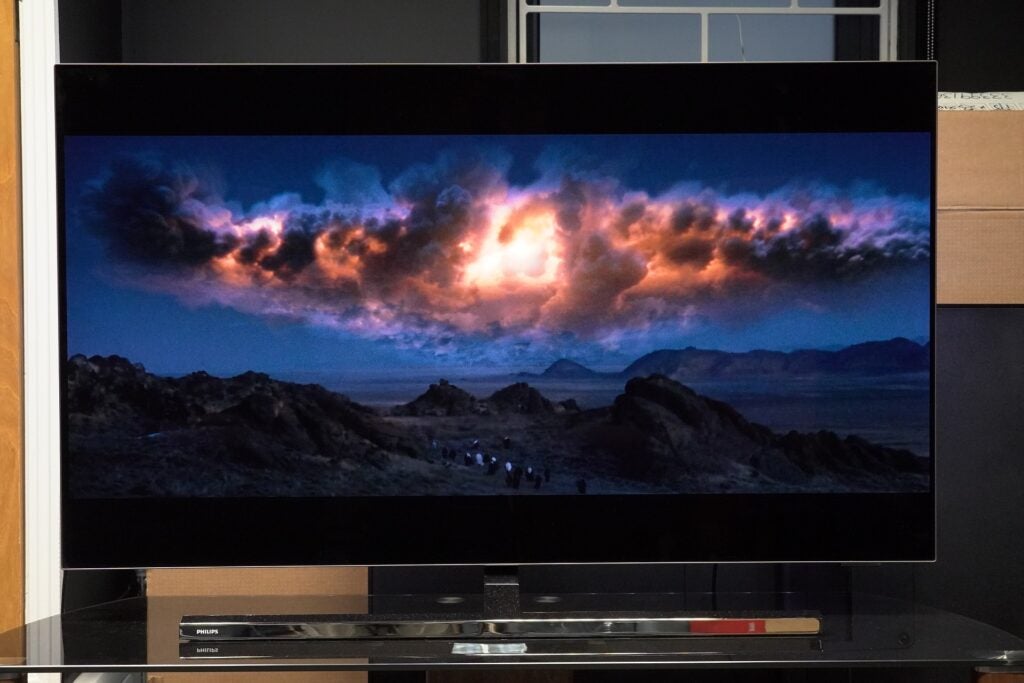
A Blu-ray of Independence Day finds the Philips on much more comfortable ground. Sharpness, clarity and detail are excellent, with healthy-looking complexions and a nice natural colour balance to the film. Play around with the settings, and you’ll eke out some punchier, more vibrant colours with the Personal/Home Cinema modes.
Sound Quality
- Weighty bass
- Big sound (in the right mode)
- Calibration helps optimise sound
Philips’ built-in sound system is one that delivers a reasonable performance that mitigates the necessity of plugging in a soundbar, although it doesn’t wholly remove that need.
In its default setting of Original, the 48OLED807 doesn’t sound particularly expansive, but a switch to the Entertainment mode makes it a more commanding performer. For example, with the Dolby Atmos track on Prime Video’s The Rings of Power, it has a bigger bass presence that underscores the footsteps of the cave troll the elves meet in the first episode.
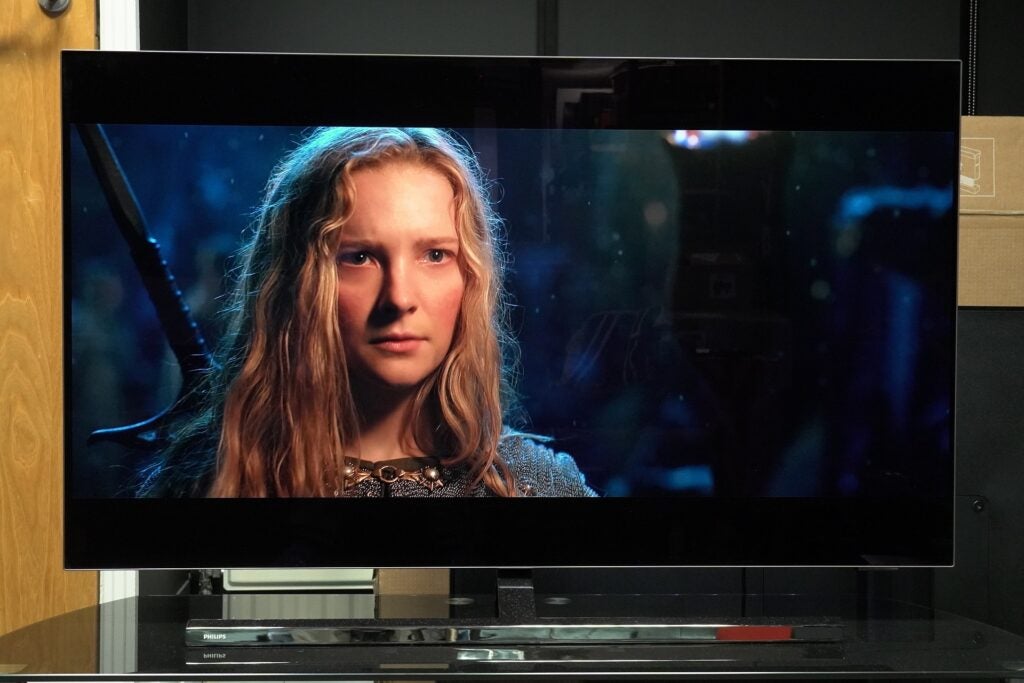
It’s still a flat soundstage as the TV doesn’t fire sound into a room, but there are good detail levels detail and the tone is well judged – Galadriel’s voice in the cave sounds appropriate echoey – with dialogue clear enough to ensure words aren’t missed. The Dialogue and Personal sound modes offer more focus on dialogue, the former at the expense of other effects, whereas the latter finds a decent balance in sharpening up what’s said while keeping other sounds in focus.

There’s decent steering of effects to the edges of the screen and beyond, while effects match their position on the screen. Perform the calibration (Mimi Defined is also supported), and the speakers elicit more detail and clarity from the midrange and treble frequencies, tightening up the bass and yielding more dynamism.
Along with Dolby Atmos support, the 48OLED807 can pass-through DTS tracks to a connected soundbar (you do need to change the settings for this to happen).
In the right mode, this Philips TV can sound big. There was lots of scale and heft to The Rings of Power and other titles, so there’s not a rush to grab a soundbar.
Save money with Trusted Reviews vouchers
Fancy getting a major discount on some of the biggest Philips products currently available? Then you’ll be pleased to know that our team has secured numerous vouchers and promo codes from Philips, all in the name of saving you money.

Latest deals
Should you buy it?
If you like sharp and expressive pictures: This TV’s picture immediately grabs the eye with its sharp, detailed images combined with punchy, saturated colours.
If you are a gaming obsessive: This TV delivers a wide variety of features on the gaming front, but LG’s OLEDs are still better in that area.
Final Thoughts
In the 48OLED807, Philips has made a TV packed full of features for TV, film fans and avid gamers, delivering impressive picture quality and good sound for its size.
It’s not as bright as expected in terms of its HDR performance, but Philips processing makes up the difference by intelligently highlighting bright spots. Gaming isn’t as fast out of the box as with other sets, but this TV will appeal to gamers with its VRR and Dolby Vision Game mode support, while smarts are provided by Android, ensuring it covers all the bases.
Ambilight is the cherry on top, offering an experience you can’t get anywhere else. This is a 4K OLED that puts in an excellent all-round performance, although – at the time of review – it comes at a premium over the LG OLED48C2.
How we test
We test every television we review thoroughly over an extended period of time. We use industry standard tests to compare features properly. We’ll always tell you what we find. We never, ever, accept money to review a product.
Find out more about how we test in our ethics policy.
Tested with real world use
Tested for a month
Benchmarked against other TVs
FAQs
The 48-inch model is the only size in the OLED807 series that doesn’t feature the high brightness OLED EX panel.








